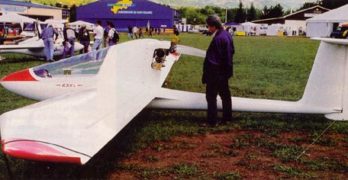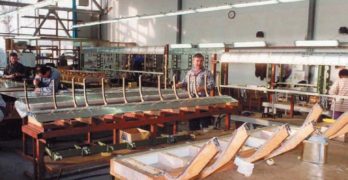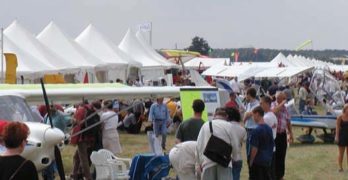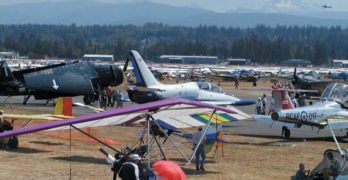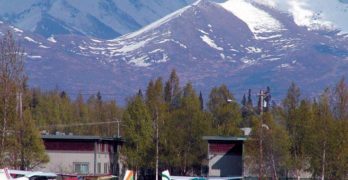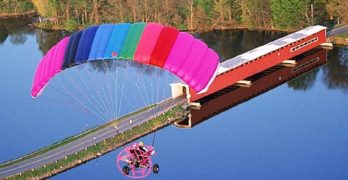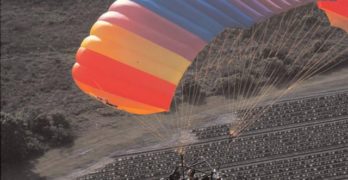The ultralight motorglider evolution continues in Europe.
Ultralight motorgliders are as rare as hen’s teeth in the U.S., but Europe is blessed with several choices that nicely complement high-end, high-priced full-size motorgliders. While America has the lovely Esprit from Aero Dovron, our soaring friends across the Atlantic continue to lead this specialized market.
Full-size (higher-weight) motorgliders start at more than $100,000 and can surpass $200,000. Those who can afford them are surely thrilled with such beautiful machines, but most of us can’t spend that kind of money regardless of their superb performance.
However, at $20-$30,000 ready-to-fly, a clean self-launching soaring aircraft is more affordable. Like their larger siblings, these efficient designs can also cruise under power respectably well, giving them broader appeal than pure gliders.
Noins’ Excel
One of the newest of the breed is the Excel from France’s Noins Aeronautiques Alpaero. Based in beautiful Tallard in the French Alps, Noins is revered by French soaring pilots.
Search Results for : CT AND hand control
Not finding exactly what you expected? Try our advanced search option.
Select a manufacturer to go straight to all our content about that manufacturer.
Select an aircraft model to go straight to all our content about that model.
Ultralight Rotorcraft? Here are Two
America is a great country, most pilots agree. We can fly our planes all over (except in TFRs) without special permission from the government. Pilots in many countries don’t have this privilege. We can fly all manner of aircraft, from factory-built, certified models to kitbuilt machines to ultralights.
We also have several regulatory programs under which we can fly our planes. You can use your pilot’s license under Part 61 and operate under Part 91. You will soon be able to get a sport pilot license that won’t require a medical and fly a light-sport aircraft with industry-devised certification (sanctioned and approved by the FAA).
Or you can operate under Part 103, the least-burdensome regulation in the flying world. All of Part 103 can easily be printed on two pages. Remarkable! After 21 years, the FAA’s simplest rule is still going strong. One proof is that designers keep introducing aircraft that fit FAR 103’s definitions.
Czech Aircraft Works
An American finds success building aircraft overseas.
This is not a story about a Czech company. It’s about an American company in the Czech Republic, a distinction that makes this story different.
For months we have been hearing and reading about sport pilot and light- sport aircraft (LSA). The FAA’s new rule is creating plenty of excitement for some very good reasons. That excitement is not confined to the U.S. Overseas manufacturers are eyeing the new rule as a way to enter the U.S. market. One of those in the best position to take advantage of the new rule is Czech Aircraft Works (CZAW).
An American In Prague
Chip Erwin hails from Wisconsin. Today, he is an American who owns a company in the Czech Republic. His CZAW has become one of that country’s largest aircraft producers. He accomplished all of this during the single decade when the Czech Republic regained its independence.
Antares 582
Antares qualifies as the first 51%-rule trike kit.
These days, hangar talk in the sport flying community seems to be focused on the FAA’s not-yet-final sport pilot rule [we have labeled it SportPlanes™—Ed]. If you are thinking of building a new airplane, you will want to know the rules that may affect your use of it.
As we wait a year or two for SportPlanes™ to prove its worth to the flying crowd, some things remain as they were. Aviation’s simplest rule defining aircraft and pilots, FAR Part 103 (ultralights) will not change. In presentation sessions, FAA officials worked to convince enthusiasts that the agency has no plans to alter this rule. Therefore, you may still fly one of the single-seat ultralights that qualify.
Long Live 51%
For many KITPLANES® readers, a primary interest is the amateur-built regulation commonly referred to as the 51% rule. As the magazine’s annual December-through-February three-part directory shows, pilots are fortunate to have hundreds of choices among attractive aircraft of every description.
Airborne Australia
A light-sport contender?
As the FAA’s proposed SportPlanes™/light-sport aircraft (LSA) rule moves steadily closer to becoming a law of the land, intense focus has been concentrated on candidate aircraft from overseas.
Though many pilots excited by the new rule are paying attention to fixed-wing designs, these are hardly the only aircraft that will qualify under the proposed regulation. In fact, consensus standards being devised by the industry to certify LSA have separate committees writing recommendations for powered parachutes and trikes (weight-shift). (Committees for gyroplanes, gliders, airships and balloons are also possible, but are not presently active.)
This month, “Light Stuff” looks at AirBorne Australia. Though its home is an immense distance from our shores and despite many other trike entries from the U.S. and overseas, AirBorne has built a solid following among Americans. However, AirBorne is one of those companies that does more than initially meets the eye.
Going Both Ways
Besides the Australian company, I can think of only two other manufacturers that currently build both ultralights and hang gliders.
Blois Airshow
This French light-airplane show Tops Anything in the U.S.
The name of the French venue is a bit awkward for Americans, though it rolls off the French tongue fluidly. Blois—pronounced Blwah—is a superb airshow that should grab the interest of every light-airplane enthusiast.
Light Airplanes Everywhere!
I’ve been to Sun ’n Fun for more than 25 years and to Oshkosh nearly as many. I spend a lot of time in the ultralight area of each, and they’re big events, no question. But both take a second seat to Blois. Yes, believe it or not, the event 185 kilometers south of Paris last August is the largest of the ultralight airshows I’ve seen.
With 90 exhibitors and more than 500 aircraft, most of which were flown to the event, Blois beats even Paradise City at the Lakeland, Florida, Sun ’n Fun fly-in. I’ve known of this 22-year-old show since the ’80s but attended for the first time last summer.
New Aircraft Arrive at Arlington
With 200-foot-tall trees and mountain peaks topped with snow throughout the year, Washington is a scenic place for an airshow. Despite a drought that caused the grass to crunch underfoot, light aviation looked alive and well at the EAA’s Arlington gathering for 2003.
Local Boys Make Good
One main attraction was the much-anticipated RV-10 four-place aircraft that drew big crowds. But a Washington-area group also revealed their efforts of past months. Sport Flight Aviation displayed in the ultralight area with the first of 50 kits in progress. Two completed Talons—the last of the old design—stood alongside a new Typhoon. The new closely resembles the old.
Company owners Todd Thompson and Ron Osborne took pride in showing me extensive CAD-generated drawings printed after a lengthy effort to document the popular northwest design. Each of the men operates a non-aviation business. They teamed up to resuscitate a company left leaderless after the death of its founder, Roger Bitton.
Antares MA-32 on Floats
A Trip to Alaska Unearthed a Hotbed of Ultralight Activity.
Alaska’s facts are amazing. Most everyone knows that the sun stays up incredibly late-in the northern oil fields of Prudhoe Bay it doesn’t set for three months! But did you also know the daily tidal change amounts to a whopping 38 feet?
More on point for an aviation magazine, Alaska boasts the highest concentration of pilots anywhere in the U.S. and probably the world. While the lower 48 states contain about one pilot in 500 among the general population, Alaska has one in 47. Even more astonishing is airplane ownership. One out of every 53 residents owns an airplane. In the contiguous United States, that figure is closer to one in 1400.
In Alaska, nobody complains about airplane noise. No wonder-with a physical size about half of the contiguous U.S., the state has only 13 highways, three of which are gravel.
Powered parachutes are on the rise
For years, I’ve said that we misnamed the class of aircraft we call ultralights. We should call them ultraslows, because that’s what they do well-fly slowly.
Powered parachutes prove this point perfectly. One look at the 22 brands sold in the U.S. will tell you that they are robustly built-some weigh more than 400 pounds empty! Weight discussions virtually ignore the wing, but it’s the wing and its rigging to the carriage that dictate a parachute’s speed.
Powered parachutes are excellent at flying slowly. They take off, cruise, and land at about the same speed: 26 mph on average.
A Misunderstood Machine
When I first tried a powered parachute, I didn’t get it. Why would any one want to fly something so slow and unmaneuverable?
I prefer flying at slower speeds, so I wasn’t questioning the slow cruise speed. I objected to the one-speed-fits-all approach, equating this to a lack of ability to maneuver out of situations.
Gemini Twin
A New Powered Parachute From a Well-Known Leader
Randy Snead branches out into his own company
Once an important figure in
Buckeye Industries, Randy is
known to many as the man
who worked on the technical
side and performed flight-testing for
Buckeye. When the former company fell
into struggle (see Editor’s Note), Randy
departed to do his own thing. Customers
who followed state, “It’s the people
behind the company” that are important.
I can find no argument with this
approach; we all tend to trust those we
know.
In turn, Randy is assisted by people he
trusts. His wife, Fern, is the business
manager and also operates the parts and
ordering department for the young firm.
Their son, Jeremiah, has experience in
general aviation aircraft, weight-shift
trikes, and powered parachutes, and he’s
built many powered parachutes. In the
EAA way, Gemini Powered Parachutes is
a family affair.
Introducing Gemini
Powered Parachutes
“It’s the American way” say others.
- « Previous Page
- 1
- …
- 51
- 52
- 53
- 54
- 55
- …
- 62
- Next Page »


